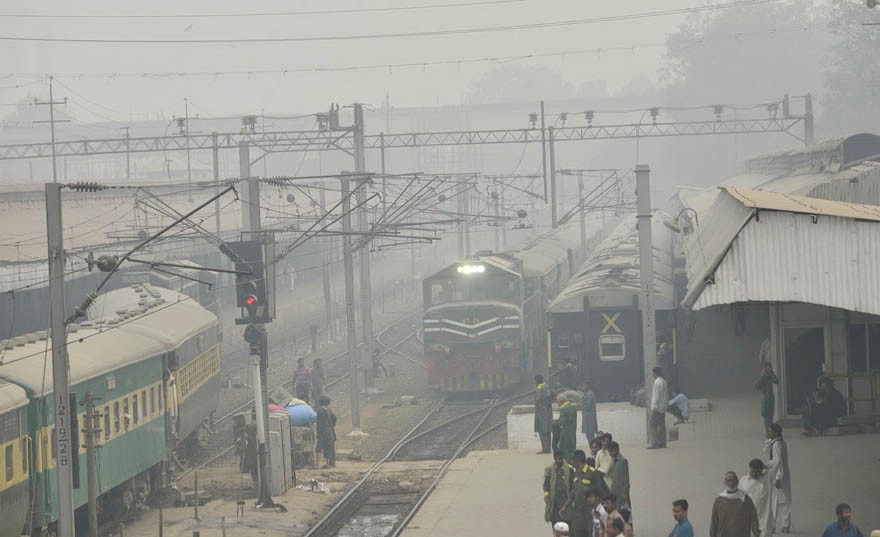
The phenomenon of smog, which is badly affecting the health and mobility of the people, speaks volumes for the provincial government’s skewed policies and development projects

Friday last, smog caused as many as 12 casualties, as low visibility resulted in a road accident on Motorway, somewhere between Lahore and Bhera. For the second consecutive year, the city is seeing this ominous pall of haze suspended in the air, also causing respiratory and throat allergies.
Technically, smog is ground-level ozone. It is caused when air pollution, industrial emissions, and fumes combine with fog and sunlight, forming a thick layer of smoke-like film in the atmosphere. The Punjab government has launched a publicity campaign, creating awareness about the adverse effects of the phenomenon and how to help the situation. There are directions for the public to use face masks and stay indoors mostly.
Smog is an urban phenomenon. Its reasons are varied. Firstly, big towns are becoming bigger because the smaller towns and rural areas have little to offer to their residents in terms of economic opportunities and municipal services. Therefore, those who can are migrating to big towns in search of better prospects. This migration trend has caught the government off guard because it has no sound policy to host the migrating population. The poor urban development planning is resulting in more slums and more smog.
This may not be the immediate reason behind increasing air pollution but it certainly serves as a background to the most immediate reasons listed in the policy document of the Punjab government issued on October 21, 2017. The document looks at ways to control smog and mitigate its hazardous impact on environment and human life.
The policy document lists various factors behind the increasing air pollution and density of smog in Lahore and its environs over the last few years: Industrial emissions, vehicular traffic, burning of rice stubbles and waste, construction activity, fugitive dust around roads and construction sites and cutting of trees.
Naseem-ur Rehman Shah, the EPA spokesperson, says the government has shut down at least 175 industrial units to minimise air pollutants and the level of smog in the city. It has banned the burning of crop residual and municipal waste, and those found violating the law shall be arrested and fined. So far, a total of 15,718 vehicle owners have been fined and 1,170 vehicles barred from plying on the roads.
The government is also mulling over banning two-stroke rickshaws to be replaced by 4-stroke ones that are said to be environment-friendly. According to Shah, various ministries and departments and their field agencies have been directed to play their roles in tackling the issue.
The policy document describes air pollution and smog as a complex and regional phenomenon but does not say much about the regional strategy to deal with it except obliquely mentioning an agreement signed in 2002 between ASEAN countries to control trans-boundary haze.
Secondly, the document does not talk about the reasons behind rapid urbanisation. According to some migration studies, the lack of economic opportunities and municipal services including health and educational facilities, as mentioned above, in rural areas are the main factors behind expanding urban centres particularly Lahore.
Thirdly, one of the suggestions to control smog in Lahore proposed by the government is the plantation of trees and increasing the number of green areas. It is interesting to note how development policies pursued by the successive governments over the last many years have turned ‘the city of gardens’ into one of the most polluted cities the world has known.
It speaks volume for the weird logic of development model followed by the government which goes like this: Chop off shadowy trees to build roads and buildings and then plant saplings along the road or around the building to compensate for the fallen trees. By the time the sapling grows into a tree we are up with another plan to construct a new building or a new road or add another lane in the existing one to deal with the increased traffic volume.
The other suggestions to mitigate hazardous impact of smog and pollution include introducing low-sulphur fuels, adopting Euro 2 standards for vehicular emissions, installation of vehicular pollution control devices, better traffic management, controlling burning of crop residue and municipal waste, and creation of woodland in and around cities etc.
These measures which are proposed in the policy document if implemented efficiently could certainly help reduce air pollution -- and, therefore, smog -- but a more proactive policy stance could lie in decentralisation of municipal services. Or, in a policy perspective that ensures that industrial activity is spread across the province evenly and is not concentrated in and around one city alone so that people looking for livelihood sources could find it at a nearby town and stay back where they belong instead of migrating to big towns.
According to a DW report on the density of smog and air pollution, Lahore is the fourth worst city of the world, followed by Beijing, Ahwaz and Mongolia. It would be interesting to know and learn from what these countries are doing to deal with the problem.